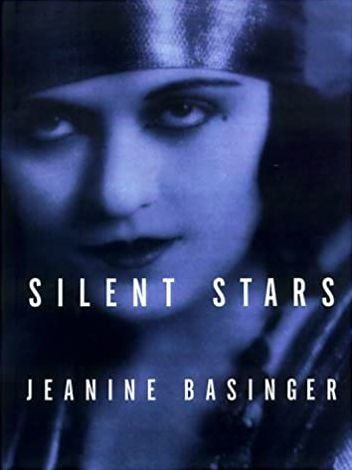Silent Stars / Edition 1 available in Paperback

- ISBN-10:
- 0819564516
- ISBN-13:
- 9780819564511
- Pub. Date:
- 11/01/2000
- Publisher:
- Wesleyan University Press
- ISBN-10:
- 0819564516
- ISBN-13:
- 9780819564511
- Pub. Date:
- 11/01/2000
- Publisher:
- Wesleyan University Press

Paperback
Buy New
$34.95Buy Used
$27.18-
-
SHIP THIS ITEM
Temporarily Out of Stock Online
Please check back later for updated availability.
-
Overview

Product Details
| ISBN-13: | 9780819564511 |
|---|---|
| Publisher: | Wesleyan University Press |
| Publication date: | 11/01/2000 |
| Edition description: | WESLEYAN U |
| Pages: | 510 |
| Sales rank: | 544,965 |
| Product dimensions: | 7.00(w) x 9.25(h) x 1.04(d) |
About the Author

Read an Excerpt
It's a world where railroad tracks run alongside every back road, and railroad handcars are free and available for stealing to use in a freewheeling chase. These chases can be serious, with a heroine needing rescue; or comic, with an eloping groom frantically chasing the speeding train that carries his would-be bride; or western, where the outlaws are creeping up on the train they're going to rob. The handcar is an all-purpose story element recognized by everyone, and none of us today has so much as seen one, much less commandeered one to solve a problem.
It's a world full of strange rituals and a great deal of attitude, and the films that illustrate it best are probably the wacky silent film comedies. Anything that can possibly go wrong absolutely does, and there's always a gun somewhere: in a pocket, a purse, or a drawer. When "Help! Help! Police!" rings out (on a title card), those reliable troopers always arrive promptly. They arrive, but they don't help much. People fall down, jump, scream, run, and bump into things, but just when all settles down, fresh disasters strike, from new and unexpected sources. All the women are indignant and the men don't know what to do about it. They just try to be stoic, and withstand assault. Everyone is concerned with money. There are rich people, and there are poor people, and there's a big gap between the two. However, lines can be crossed, because the poor victimize the rich with real dedication and true imagination and resource. This doesn't mean that silent film comedy -- or silent film in general -- suggests that there is no evil in the world, no poverty, no catastrophe. But it suggests that individuals can triumph and badthings can be overcome with enough enthusiasm, hard work, optimism, and decency. To look at these films today is to learn about the optimism of Americans. It's not just that people are so ingenious at solving problems, but that there are so many problems to be solved. While characters lie asleep in their beds at night, burglars are breaking in downstairs. If they stand under a drainpipe, it will break and they will be drenched. If they take to the floor in a rented tuxedo to tango, trouser seams will give way. All the machinery they try to operate will backfire, break down, or run away with them. Opportunity knocks, but on their heads as well as their doors. On the other hand, they have a chance to move forward and accomplish something, even while waging a constant battle against disaster. Their glass is both half empty and half full. They teeter between profit and loss, winning and losing, loving and hating. It's a wild and unpredictable place full of crooks and con artists, suckers and rubes. Anything can happen. It does. They survive. And that's America.
Watching silent films from the teens and twenties, one observes a society undergoing rupture. At first, the films reflect an attempt to hold on to innocence. The women are childlike, the men impossibly heroic. Many of the stories concern children, and sex is always a cautionary tale. D. W. Griffith's is the dominant sensibility, with its roots in agrarian society and the melodramatic theatrical tradition. By the end of 1919, after World War I has given the nineteenth century the coup de grace, the twentieth century cracks open. The tempo changes from the waltz to the Charleston, and the energy, pace, and rhythm of silent films begin to produce unexpected riffs, shifts in tone, and wildly improvisational scenes. The silent film becomes visual jazz. Women cut their hair, shorten their skirts, and become aggressive. Men start swanning around in impeccable evening clothes or exotic Arabian garb. Both women and men are looking for sexual satisfaction or, rather, sexual stimulation. The rural world of sun-dappled forests, flowing rivers, and lazy farms with clucking chickens fades away to be replaced by art deco apartments, limos, and roadhouses selling "hooch." Stars become more casual, and the acting style shifts from one of declamation, broad gesture, and overt emotion to a loose naturalism that will lead directly to the sound era. The fantasies of the audience change from grand dreams of a generic quality -- settling the frontier, owning their own land, escaping oppression -- to specific dreams fueled by the movies themselves: wealth, social position, passion, clothes, furniture, glamour, exotica, and, of course, sex.
The twenties became a movie-dominated decade, and the silent stars its beautiful, representative citizens. F. Scott Fitzgerald wrote, "It was an age of miracles, it was an age of art, it was an age of excess, it was an age of satire." It's the perfect introduction to silent film and the world of stars who did not speak.
